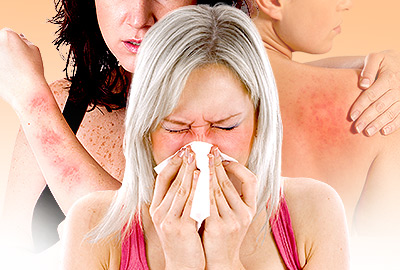Allergy is our immune system's response to something that is usually harmless to most people, such food, dust, or pollen. It can be potentially life-threatening, particularly when the reaction is severe enough to cause anaphylactic shock, so allergies should always be properly diagnosed.
Many middle-aged women suffering from allergies take advantage of allergy tests, whose goal is to identify an allergen, a substance that triggers the allergic reaction. The following are the types of available allergy tests:
Skin Tests
They are the most common of all allergy tests and involve applying possible allergens on the skin and observing the reaction. Allergy to a given substance is characterized by a red bump around the spot where it was applied. Skin tests come in four types:
Skin prick test. It involves putting small water drops containing allergens on the skin of the lower arm or the back, then slightly pricking the skin at each site to enable the allergens to penetrate the skin. The results are visible within 15 minutes, and the test is effective in identifying allergies to pollen, mold, pet dander, dust mites, and certain foods.
Intradermal test. Similar concept as in skin prick test, but intradermal test involves injecting allergens into the skin. It can be helpful in identifying weak allergens and is often used if skin prick test did not produce sufficient results.
Skin scrap/scrape test. Also used as a secondary test in case the results of the skin prick test were uncertain, it involves removing a small piece of skin and rubbing allergens over it, which enables them to enter the skin even deeper.
Patch test. It is used to identify allergens that cause a delayed reaction, one to three days after the exposure, such as particular substances found in medications, cosmetics, jewelry, or gloves. A patch, typically containing 30-40 and up to 150 allergens, is applied on the back and left there for 48 hours.
Blood Test
It measures the blood levels of IgE, an allergen-specific immunoglobulin, which is a type of antibody produced by the immune system when it detects harmful substances in the body. There are three types of blood tests, ELISA (Enzyme-linked immunosorbent assay), FEIA (fluorescent enzyme immunoassay), and RAST (Radioallergosorbent test).
Allergy blood test is helpful in diagnosing food allergies, for example for milk or wheat, as well as common environmental triggers, such as trees, grasses, molds, and pet dander. The results are ready within a week.
Challenge Test
It is only used if the skin and blood tests did not provide clear results. It involves eating or inhaling the suspected substance in incremental doses, usually food or medication, such an antibiotic, and watching the reaction. The test must be performed under the supervision of a medical doctor, because it can cause a severe allergic reaction.
More Information
Testing for allergies usually follows the same protocol: skin test, then blood test, and challenge test as the last resort. Skin tests are the preferred method, because they are less expensive and give much faster results in comparison to a blood test.
However, certain factors prevent menopausal women from having skin tests. They include medications, such as antihistamines, that might alter the results. Also some skin conditions, like eczema or psoriasis can make reading of the results difficult.
Allergy testing is important in diagnosis allergies, but it has its limitations, for example, sometimes it gives incorrect results. For this reason, allergy tests are used to complement a physical exam and a thorough medical history. Good observation to associate the symptoms with various exposures can help you identify allergens even more accurately. If you also suffer from other menopausal symptoms, you might be interested in learning how does menopause affect allergies.
Sources
- American Academy of Allergy Asthma & Immunology. (2017) Allergy Testing. Retrieved August 14, 2017 from https://www.aaaai.org/conditions-and-treatments/library/at-a-glance/allergy-testing
- American College of Allergy, Asthma & Immunology. (2014). Allergy Testing. Retrieved August 14, 2017 from http://acaai.org/allergies/treatment/allergy-testing
- National Institutes of Health. (2016). What kinds of allergy tests are there? Retrieved August 14, 2017 from https://www.ncbi.nlm.nih.gov/pubmedhealth/PMH0088215/




